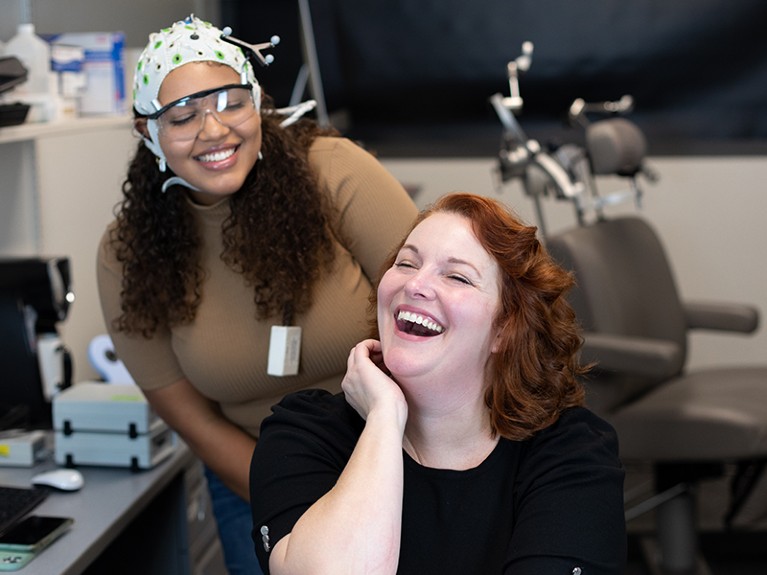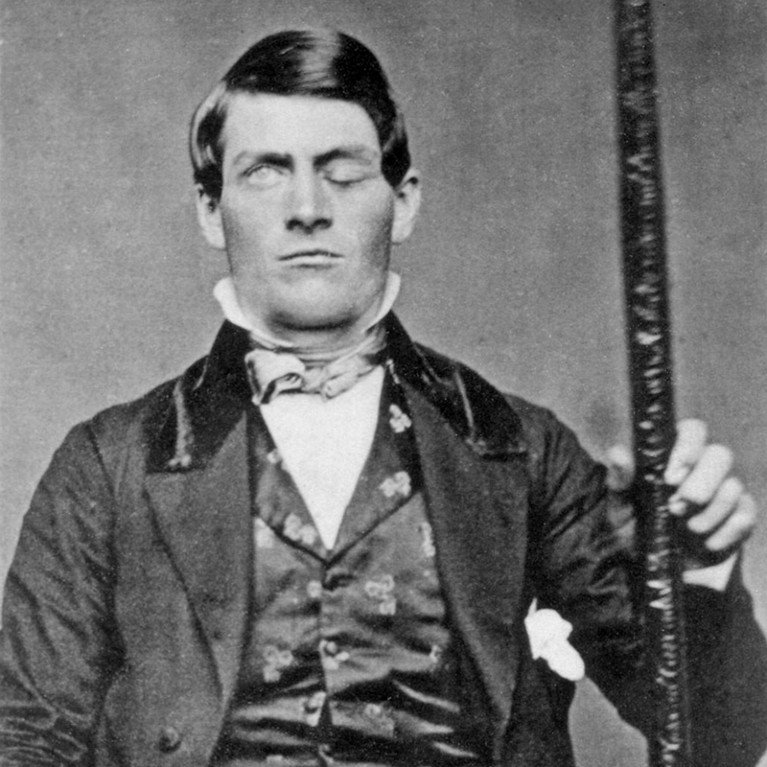
Chantal Prat (right) with her daughter Jasmine, wearing an electrode cap.Credit: Shaya Lyon
Chantel Prat researches individual differences in language processing and cognition at the University of Washington in Seattle. Her first book, The Neuroscience of You, explains how human brains work, how they help us to survive and why we should embrace our uniqueness. Published last year, it has been praised by numerous outlets and is a bestseller at the Elliot Bay Book Company, Prat’s favourite Seattle book shop.
When did you first fall in love with the brain?
I was 17 years old and in a pre-med programme at the University of California, San Diego. In one of my first psychology classes, we learnt about the railway construction foreman Phineas Gage, who had a metre-long spike forced through his frontal lobe in a work accident in 1848. Gage walked away from this gory accident with most of his physical abilities intact, but the things that made him him — his way of thinking, feeling and behaving — changed.
Once a very dependable man, he became much more unpredictable. The way an injury to Gage’s brain changed his personality was my first insight into the relationship between the mind and the brain at the level of the individual, and the differences in the ways that brains work that make you you.
John Polich — my instructor in the honours programme and a neuroscientist who studied cognitive psychology for his PhD — advised me to study psychology, to see how the brain gives rise to human experience. Back then, neuroscientific insight was limited, because the field was relatively new.

Phineas Gage holds the tamping iron that was driven through his head in 1848. He lived for a further 12 years.Credit: GL Archive/Alamy
Two years after that pre-med programme, my daughter Jasmine was born. I was a single mum, both as an undergraduate and a graduate student.
(Alongside the brain, and horses, Jasmine is the other love of my life.)
I first recorded Jasmine’s brain when she was 17 months old. She helped me get my first job, because the cognitive neuroscience lab I wanted to join at UC San Diego wanted people with baby-charming experiences. Getting a baby to wear an electrode cap (like a swimming cap with devices sewn into it that allow us to eavesdrop on the electrical activity of the brain) is still one of the hardest jobs in neuroscience, I think.
What inspired you to write The Neuroscience of You?
In 2016, talking to my husband Andrea Stocco — a fellow cognitive neuroscientist here at Washington — I wondered why people are so often convinced that they’re right. If I can show how different brains make different inferences in the same situation, maybe I can get them to relax their view that their reality is the only reality.
I thought it was important to give people concrete data about the ways that different brains understand the world because it might help us connect with and understand others who work differently. I wanted to walk someone to the point in the book where they can be curious about different opinions, rather than feeling threatened about their own beliefs.
As a first step, I collected names of agents from people I knew who either had written books or were thinking about it. I then started calling them, describing myself and my book idea. I was surprised by how many thought these ideas were new, because most books said brains work with a one-size-fits-all approach. My agent, Margo Beth Fleming, was a clear match in terms of her expertise, portfolio, communication style and the kind of coaching and support I felt I needed. She has been a lighthouse for this whole process.
What was your experience of writing The Neuroscience of You?
In 2019, I attended the Tribeca Film Festival in New York City because a movie showing there — I am Human, which explores advances in neurotechnology by following three people with neurological conditions — features my research. While I was there I met with representatives of different publishing houses.
Jill Schwartzman, who became my editor at Penguin, asked if I had time to write the book. I was really underprepared. I thought I had time in my schedule, but I still had to do my academic work.
Then, six months in, the pandemic blew everything up. My brain responded to it in a way that seemed very different from the people around me. Some were getting into the best shape of their lives. Others were cooking more than ever. I started thinking about stress and cortisol in the brain and realized that our genes and our neurotransmitters influence the way we respond to stress.
Writing the book was both a scary and a vulnerable thing — I share lots of personal information. The response has been overwhelmingly positive. People reach out on my website and tell me about themselves, reciprocating personal things and how important it is for them because they’re struggling with something — Parkinson’s disease, for example. My agent said I would have conversations with thousands of people I’d never meet, which is really cool.
What advice would you give to a researcher wanting to write a popular-science book?
Start with an idea that you love, then get people you trust — an editor, agent or fellow author — to talk you through the process. You might not know what is missing, so expert guidance is important.
Also, talk to other scientists who have written books. I received recommendations for agents and guidance on proposal writing, for example.
I remember my agent asking what I thought was important in an imprint, and I had no idea what one was. I thought it was a font. (It’s a trade or brand name used by publishers to market books to different consumer segments.) She showed me a family tree of publishing houses, explaining imprints, their specializations, audiences and expertise. Without a guide, I would have been very lost.
I write in the book that it is more about ‘finding your lane’ than ‘winning a race’, which is good writing advice. Don’t compare yours to other books. If you’ve found your lane, occupy that space and enjoy it.
The historian Margaret O’Mara, author of the 2019 book The Code about Silicon Valley, gave me valuable advice — divide stuff into what you have to do, what you want to do and what others want you to do. This puts your workload in perspective.
With the book-promotion schedule, I did 12-hour days of radio tours at first. I still do three to four interviews a week — whether podcasts, radio or other media.
The nice thing about an academic book is that, unlike a popular title that comes out with a buzz that fades, this is science — it will be true in six months, so I’m pacing myself.
Inevitably, it will come back to bite me at some point and I will have to say no to more, but it is really exciting. In March, for example, I’ll be giving a talk at the Osher Lifelong Learning Institute at the University of Washington, for people over the age of 50. Opportunities like these remind me why I am excited, connecting with lifetime learners and discussing individual differences.

 Why women aren’t from Venus, and men aren’t from Mars
Why women aren’t from Venus, and men aren’t from Mars
 Cognitive neuroscience at the crossroads
Cognitive neuroscience at the crossroads








